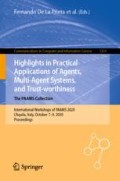Abstract
Social media platforms have limited mechanisms for authenticating the veracity of the shared information. This leads to widespread rumors and misinformation. Quite often, these rumors can lead to drastic consequences such as shocking the stock market or violent actions against target groups. Understanding the factors that lead to rumor propagation is key to its detection and eventual mitigation. Accordingly, this paper studies the possible factors that may influence how a rumor spreads. We discuss the types of personality traits that are more likely to participate in the propagation of a rumor, and present a survey of pertinent research efforts that support this claim. In addition, we offer an analysis of the lifetime of a rumor using a large dataset collected from Twitter, which shows that people with a higher number of followers are generally regarded to be more trustworthy and thus can influence the rate of propagation of a rumor. Our study leads us to confirm that personality traits affect the rate of spreading of a rumor.
Access this chapter
Tax calculation will be finalised at checkout
Purchases are for personal use only
Notes
- 1.
- 2.
An easy-to-use Python library for accessing the Twitter API.
- 3.
- 4.
References
Romero, D.M., Galuba, W., Asur, S., Huberman, B.A.: Influence and passivity in social media. In: Gunopulos, D., Hofmann, T., Malerba, D., Vazirgiannis, M. (eds.) ECML PKDD 2011. LNCS (LNAI), vol. 6913, pp. 18–33. Springer, Heidelberg (2011). https://doi.org/10.1007/978-3-642-23808-6_2
Lai, K., et al.: Who falls for rumor? Influence of personality traits on false rumor belief. Personality Individual Differ. 152, 109520 (2020)
Kwon, S., Cha, M., Jung, K.: Rumor detection over varying time windows. PloS One 12(1), e0168344 (2017)
Vosoughi, S., Mohsenvand, M.N., Roy, D.: Rumor gauge: predicting the veracity of rumors on Twitter. ACM Trans. Knowl. Discovery Data (TKDD) 11(4), 1–36 (2017)
Alkhodair, S.A., et al.: Detecting breaking news rumors of emerging topics in social media. Inf. Process. Manag. 57(2), 102018 (2020)
Li, Q., et al.: Rumor detection on social media: datasets, methods and opportunities. arXiv preprint arXiv:1911.07199 (2019)
Zeng, L., Starbird, K., Spiro, E.S.: Rumors at the speed of light? Modeling the rate of rumor transmission during crisis. In: 2016 49th Hawaii International Conference on System Sciences (HICSS). IEEE (2016)
Chen, X.: The influences of personality and motivation on the sharing of misinformation on social media. In: IConference 2016 Proceedings (2016)
Sinnenberg, L., et al.: Twitter as a potential data source for cardiovascular disease research. JAMA Cardiol. 1(9), 1032–1036 (2016)
Zubiaga, A., Liakata, M., Procter, R.: Learning reporting dynamics during breaking news for rumour detection in social media. arXiv preprint arXiv:1610.07363 (2016)
Myers, S.A., et al. Information network or social network? The structure of the Twitter follow graph. In: Proceedings of the 23rd International Conference on World Wide Web (2014)
Jiang, J., et al.: Rumor source identification in social networks with time-varying topology. IEEE Trans. Dependable Secure Comput. 15(1), 166–179 (2016)
McCrae, R.R., John, O.P.: An introduction to the five-factor model and its applications. J. Personality 60(2), 175–215 (1992)
McElroy, J.C., Hendrickson, A.R., Townsend, A.M., DeMarie, S.M.: Dispositional factors in Internet use: personality versus conitive style. MIS Q. 31(4), 809–820 (2007)
Ross, C., Orr, E.S., Sisic, M., Arseneault, J.M., Simmering, M.G., Orr, R.R.: Personality and motivations associated with Facebook use. Comput. Hum. Behav. 25(2), 578–586 (2009)
Correa, T., Hinsley, A.W., De Zuniga, H.G.: Who interacts on the Web?: the intersection of users’ personality and social media use. Comput. Hum. Behav. 26(2), 247–253 (2010)
Sudhir, S., Unnithan, A.B.: Marketplace rumor sharing among young consumers: the role of anxiety and arousal. In: Young Consumers (2019)
Chua, A.Y.K., Aricat, R., Goh, D.: Message content in the life of rumors: comparing three rumor types. In: 2017 Twelfth International Conference on Digital Information Management (ICDIM). IEEE (2017)
Acknowledgment
This work has been supported by Ali Souidan, a bachelor student in German University in Cairo, who was responsible for the data collection and classifying user interests parts.
Author information
Authors and Affiliations
Corresponding authors
Editor information
Editors and Affiliations
Rights and permissions
Copyright information
© 2020 Springer Nature Switzerland AG
About this paper
Cite this paper
Mikhaeil, M., El Mougy, A. (2020). The Effects of Personality Traits on the Lifetime of a Rumor. In: De La Prieta, F., et al. Highlights in Practical Applications of Agents, Multi-Agent Systems, and Trust-worthiness. The PAAMS Collection. PAAMS 2020. Communications in Computer and Information Science, vol 1233. Springer, Cham. https://doi.org/10.1007/978-3-030-51999-5_9
Download citation
DOI: https://doi.org/10.1007/978-3-030-51999-5_9
Published:
Publisher Name: Springer, Cham
Print ISBN: 978-3-030-51998-8
Online ISBN: 978-3-030-51999-5
eBook Packages: Computer ScienceComputer Science (R0)

